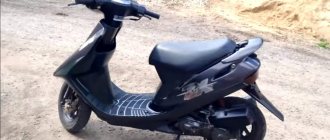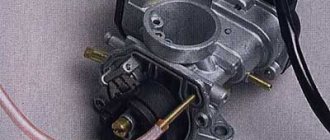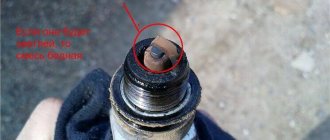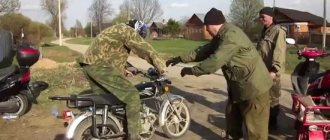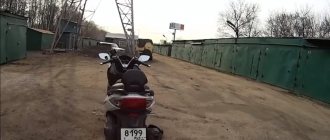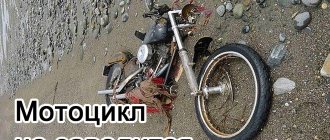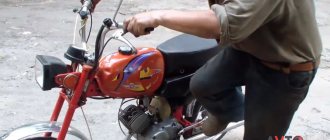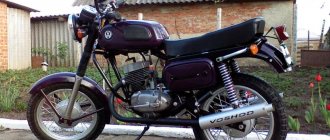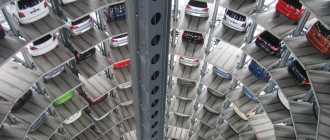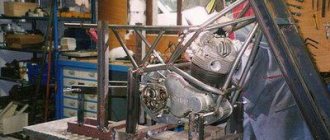Imagine: Sunday, great weather, in the mood to go for a ride. In anticipation of a pleasant trip, you approach your Yamaha Drag Star 400 cruiser, insert the key into the ignition, turn it, but you can’t hear the usual sound. And it would be nice if there was silence, but the car makes strange, unpleasant creaks or even “shots”. This situation can happen with any bike (both Ducati and Honda), with any motorcycle owner. Weekend ruined? Not if you correctly identify the cause and eliminate it. Our article will help you do this.
Checking the starter. Does it work when you press the button?
- If the ABS and other instrument lights on the panel do not light up or go out quickly, and the starter turns slowly, the most likely cause is a discharged battery. Solution: jump start, kickstarter, or charge the battery.
- If the engine cannot be started from the starter, it does not turn over, the problem is a discharged battery or a problem with the starter itself or the fuse, another option is that the equipment is in gear with the footrest set.
- If everything is fine with the starter, the problem is probably a lack of fuel (look at the tank), a closed or clogged fuel tap or gasoline hose. Remove the hose from the injector. If there is no fuel in it, the fault may be hidden in the tap or fuel pump: the first one is easy to wash yourself, but the second one will have to be addressed to specialists.
A suddenly dead battery or a malfunction in the ignition system will not be a problem for you if you know how to jump start a bike. But if you can’t launch it from kickstarter, you can’t do it without contacting a motorcycle service center.
Checking the spark plugs
If everything is fine with the starter, the problem may be in the air-fuel mixture ignition system. In normal condition they should be light brown and dry. If they smell of fuel, are black and wet, and gasoline falls into the combustion chamber, the cause may be careless handling of the equipment or a malfunction of the bike. Dry and blow out the spark plugs, put them back in place and try to start the engine again. And always carry a set of spare candles with you, especially on long tourist trips in unfamiliar areas, so that trouble does not take you by surprise far from civilization.
What could go wrong
- Ignition - no spark, the spark is weak, or it comes out “every once.”
- Gasoline supply - fuel is not supplied to the combustion chamber or is supplied in insufficient or excess quantities, does not enter the carburetor or injector, the quality of the fuel does not meet the standard.
- Air supply - the air filter is clogged, the damper adjustment is incorrect, the air filter housing is damaged, the intake pipe is “sucking”, the filter filling is missing.
Diagnostics will help to find out the cause of the breakdown.
Read also: Rice soup with minced meat
The motorcycle starts and immediately stalls
The engine may suddenly stall due to an ignition or power failure. Mechanical breakdowns of the chassis are much less common. The engine immediately stalls if it does not have enough fuel or, conversely, there is too much of it, and the reason for this may be a malfunction of the spark plugs, carburetor, fuel pump or hoses. Tuning and flushing the carburetor will be the most likely solution. If the spark plugs are cleaned and the carburetor is working properly, the breakdown will probably be found in the ignition coil or starter enrichment.
What does the contactless ignition system on the Ural and Dnepr motorcycle provide?
- No headaches for the motorcycle owner when operating it;
- Starting the engine in wet and cold weather;
- Failure-free operation of the ignition system;
- Increased driving characteristics of the motorcycle as a whole;
- Increased candle life;
- Starting the engine when the battery voltage drops to 6 volts;
- Constant, not changing over time, ignition timing;
- The ignition coil cannot overheat.
- Powerful, required color, sparking.
Motorcycle won't start when cold
- Trying to start the engine in cold weather? You'll have to work hard to "wake up" him. The fuel mixture in the combustion chamber ignites only at a certain temperature, and engine oil becomes very thick in cold weather. We check the condition of the oil and depress the clutch during the starting process.
- Was the equipment stored in a poorly heated garage during the winter? In spring, rust appears on its components due to high humidity. Before you go on your first spring trip, the rust from the ignition parts must be removed.
- Difficulties with cold starting also occur in the warm season. If the motorcycle does not catch (does not start) after a long period of inactivity, you need to check the condition of the carburetor or increase the fuel level in the float chamber.
Fuel quality
Normal operation of the internal combustion engine depends on the quality of gasoline. Moreover, when “hot” the engine is less susceptible to this factor, but “when cold” it may not start at all.
If your motorcycle does not start after a recent refueling, you may have been given poor quality fuel. If you refueled from a canister, condensation, rust particles or sand could get into the tank along with gasoline.
To correct the situation, drain low-quality gasoline from the fuel tank and carburetor. With injection engines it is more difficult - in order to drain fuel from the tank, you may have to remove the fuel module. This way, low-quality fuel will not pass through the pump and fine filter.
If you don't know how to get to the spark plugs or carburetor, don't torture yourself and your motorcycle in vain. Contact the professionals: call a field service specialist or call a motorcycle tow truck.
Gasoline supply
If the faucet flows fuel normally, check to see if sediment has accumulated in the carburetor float chamber. Open the drain hole, drain the contents, close it, and try to start the engine again.
To find out whether gasoline is entering the combustion chamber itself, you will need a spark plug wrench. Remove the armor wire from the spark plug, open the tap and operate the starter, then unscrew the spark plug and inspect the insulator. If it is dry, there is a problem with the fuel supply. A wet spark plug will need to be dried before screwing it back in.
Checking the fuel supply.
Remove the fuel supply hose from the carburetor/injector.
Carefully! There must be gasoline in the hose, and it may be under pressure.
If there is no gasoline there, then the problem is most likely in the fuel pump or fuel tap.
And if you can try to solve the problem with the faucet yourself (rinse, blow out, clean), then it is better to entrust the problem with the gas pumps to specialists, so as not to make things worse.
All these actions led to nothing?
Checking cylinder compression
If the Minsk motorcycle still does not start, then you need to check the compression. To do this, you need to unscrew the spark plug and pour a few grams of gasoline directly into the cylinder through the vacated hole.
Next, tighten the spark plug and try to start the motorcycle. After this, the engine should start and after running at full speed for a few seconds, stall.
If the motorcycle starts, then you should move on to more careful adjustment of the carburetor. Namely, using the appropriate bolts, try to adjust the opening of the idle air damper and adjust the proportions of the mixture entering the combustion chamber.
If the Minsk motorcycle does not start, there is a spark - this means that the mixture entering the combustion chamber does not reach the required compression and does not ignite.
There are many reasons why there may be no compression in the cylinder of a Minsk motorcycle:
- If the engine is equipped with valves, you may need to check for cracks on them. Also, the valves may not fit tightly to the “seat” or it may have quite a lot of wear.
- Burnout of the cylinder head gasket due to wear;
- Cylinder seizure due to engine overheating;
- Severe wear on the cylinder or piston;
- The cylinder rings have collapsed or are not installed correctly;
- Cracks have formed on the piston or cylinder due to long use;
- For engines equipped with valves, the gas distribution valve circuit may be broken, or this mechanism may not be installed correctly.
Therefore, for subsequent diagnosis of a malfunction of the Minsk motorcycle, it is necessary to completely disassemble the cylinder. It should be done slowly and ensure the cleanliness of all components.
Armed with patience, you need to examine all available spare parts for faults, defects, or simply incorrect installation.
Having made a lot of effort to carry out the described manipulations, it is safe to say that all attempts were made to eliminate the cause of the motorcycle malfunction: the functionality of the fuel system and ignition system was checked, and the presence of compression was checked.
But if the Minsk motorcycle still fails to start, then perhaps you should contact a motorcycle service center with specialized specialists for accurate diagnostics and subsequent repair of the motorcycle.
Carburetor problems
So, you are the owner of a Minsk motorcycle, the carburetor of which regularly receives gasoline, and the spark plug provides a spark sufficient for stable operation of the engine.
But this is not enough for the motorcycle to start. An unscrewed dry spark plug showed that the problem was in the carburetor, namely, the incoming fuel could not reach the combustion chamber of the cylinder. In this case, it is necessary to remove and clean the carburetor.
To clean the carburetor, it must be removed by disconnecting it from the cylinder and air filter. You also need to disconnect the throttle cable and gasoline hose. To prevent dirt from getting inside the carburetor, before further disassembly you must not be lazy and completely clean it.
It is necessary to disassemble and reassemble the carburetor cleanly, since dust or dirt particles getting inside will lead to unsatisfactory operation of the motorcycle engine even after washing it.
Upon completion of disassembling the carburetor, it is necessary to clean all its parts from accumulated dirt, and also blow out all channels and the jet with a compressor. It will not be superfluous if you additionally blow out the air filter and gas tap.
After completing all the manipulations, you need to install the carburetor in place. During assembly, as well as during disassembly, it is necessary that no dirt gets inside the carburetor.
After installation, make sure that the carburetor fits tightly to the cylinder. If you did everything correctly, you can be sure that after some effort your Minsk motorcycle will be able to start.
If the moped is not
Sometimes it happens that the moped does not want to start after several hours of inactivity. However, after warming up, it works and starts stably. Let's figure out why this happens.
When the engine is cold, all clearances (in the piston, in the valves, etc.) are far from ideal. Plus, when fuel gets on cold engine parts, it evaporates worse and therefore ignites worse. Because of this, during a cold start the engine needs a richer mixture than usual. It is for this purpose that devices are made on carburetor engines to enrich the mixture at start-up.
On the Alpha moped (and similar ones), an air damper is installed. It reduces the air flow and thereby enriches the working mixture. The damper has two positions: “closed” - the lever is raised up, “open” - the lever is lowered down. When starting “on a cold” air damper must be closed (lift the lever up) . When the engine runs for a while with the throttle closed, it needs to be opened. Driving with the throttle closed will lead to increased fuel consumption and the formation of carbon deposits on the spark plug and piston.
What to do if a cold moped does not start even with the throttle closed? Try using a syringe to fill in 5-7 ml. gasoline directly into the carburetor inlet pipe. If the moped starts after this, then the carburetor needs to be adjusted. If it doesn’t start, check the spark and compression (see above).
Checking the engine power system
First of all, you need to make sure that there is enough gasoline in the gas tank. There is a small tube inside the gas tank that takes gasoline not from the bottom of the gas tank, but a little higher. Therefore, it may turn out that there is still gasoline in the tank, but it does not flow into the carburetor. Therefore, if possible, add gasoline to at least half the tank and try to start the moped again. Perhaps this is the reason.
You also need to know that the gas tap of the Alpha moped has two positions: in one, it takes gasoline closer to the bottom of the gas tank, and in the other, a little higher. If you don’t know in which position the gas tap is open, try installing it in a different position, maybe this will help.
It is very convenient to check the gasoline supply if you have a transparent tube from the gas tank to the carburetor, or have a replaceable gas filter installed. In this case, you can immediately see whether there is gasoline or not.
There is also another simple check of the power system: take a small amount (5-10 ml) of gasoline into a syringe, remove the air intake tube from the carburetor and pour gasoline directly into the carburetor. If after this the moped starts up, or as they say “catch,” then the reason is definitely in the gasoline supply and you need to check the fuel supply and carburetor.
If after all the described checks the problem is not found, there is one more check left - checking the engine compression.
Starter turns but won't start
If the starter of the described equipment spins when you turn the key in the ignition, but the engine does not show any signs. The cause of the malfunction may lie in both the electrical equipment of the car and the mechanics. Auto electrician malfunctions can be as described above, except for malfunctions associated with the starter and its circuits, plus the following reasons:
- Malfunction of the high pressure fuel pump (HPF)
- Mechanical engine failure
- “Airing” of fuel equipment
- Immobilizer malfunction
- Lack of diesel fuel in the tank
- Fuel filter clogged
- Chip in the key is faulty
- Clogged fuel lines
- Check valve failure
- Mechanical faults of injectors
The motorcycle suddenly stalled and would not start
Remember what preceded the breakdown:
- While driving, the power dropped sharply, the engine began to run jerkily, then fell silent - perhaps there was not enough fuel. The gas tank has run out or the tap is clogged.
- The motorcycle stalled in the rain or after driving through a puddle - the air filter or wiring was flooded, or both. Dry everything you can reach.
- While driving or at the start, the engine ran smoothly, then simply stalled - there was an electrical problem. The spark disappeared, the mass fell off, the coil or switch “died”. If this happens a short time after starting, check whether you forgot to open the fuel tap.
- The running engine “troil” did not develop high speeds, and after stopping it could not start - problems with the ignition settings or the carburetor was incorrectly adjusted.
Electric starter does not turn on
The ignition button is off - red on the right side of the steering wheel.
Dirty contacts in the ignition switch or near the starter button - unscrew the switch and clean the contacts using a special sprayer for electrical installations.
Battery voltage is too low: If you hear the characteristic sound of the starter relay firing, charge or replace the battery.
The main fuse or ignition relay has blown - check and replace what is needed.
A starter malfunction, for example, due to burned out stator windings or core, is unlikely to be corrected on your own, so contact a service center.
contents .. 1 2 3 ..TROUBLESHOOTING FOR THE RACER RC200LT MOTORCYCLE
Problem
| Cause | Solution | |
| 2.Spark plug covered with soot | 1.Mixture too rich | Adjust the carburetor |
| 2.Idle speed too high | ||
| 3.Unsuitable gasoline | Replace | |
| 4. Air filter clogged | Clear | |
| 5. The spark plug contact has become loose | Replace or tighten | |
| 6.Unsuitable engine oil | Replace | |
| H.No charging current | 1 Open, shorted or loose lead wires | Tighten or repair |
| 2.Short-circuited, grounded or open magneto winding | Replace | |
| 3.Short-circuited or open-circuited regulator/rectifier | Replace | |
| 4.Charge current is below the required value | 1. Lead wires are shorted, open or loose | Repair or tighten |
| 2. Stator windings are grounded or open-circuited | Replace | |
| H. Defective regulator/rectifier | Replace | |
| 4.Defective battery plates | Replace the battery |
| Problem | Cause | Solution |
| 2.Squealing brakes | 1. Soot on the surface of the pads. | Clean the surface with sandpaper |
| 2.The pads are located at an angle | Adjust | |
| 3.Wheel bearing damaged | Replace | |
| 4. The gasket is worn out | Replace | |
| 5.Foreign substances have entered the brake fluid | Replace fluid | |
| 6. The return hole of the brake master cylinder is clogged | Dismantle and clean | |
| 7.Sanded pad surface | Clean the surface with sandpaper | |
| 8. Loose front axle or | Tighten to specified torque | |
| rear wheel | moment |
| Problem | Cause | Solution |
| 2.Problems at medium and high speeds | 1.The main jet or air jet is clogged | Check and clean |
| 2. The needle jet is clogged | Check and clean | |
| 3.Fuel level is set incorrectly | Check | |
| 4. Throttle valve does not work well | Check operation | |
| 5. The fuel filter is clogged | Check and clean | |
| 3.Overflow and fluctuations in fuel level | 1.Needle valve worn or damaged | Replace |
| 2.Needle valve spring is broken | Replace | |
| 3.Float does not work properly | Check and adjust | |
| 4.Needle valve is clogged | Clear | |
| 5.Fuel level is too low or high | Adjust |
| 4. The engine does not develop power | 1. Excessive wear on cylinders or piston rings | Replace |
| 2.3sticking of piston rings | Replace | |
| 3. Gas leaks from the crankshaft oil seal | Replace | |
| 4. Incorrect spark plug gap | Adjust or replace | |
| 5. Air filter clogged | Clear | |
| 6.The fuel level in the float chamber is not adjusted | Adjust or replace | |
| 7.Fuel filter clogged | Clean or replace | |
| 8. Air leak from the inlet tube | Tighten or replace | |
| 9.Slipping or wear of V-belts | Replace | |
| 10.Damaged/worn rollers on the drive side | Replace | |
| 11.The spring on the driven side is weak | Tighten | |
| 12. Excessive amount of fuel/fuel-air mixture due to defective enrichment | Replace |
| Problem | Cause | Solution |
| Low compression level | ||
| 1. Excessively worn cylinder or piston rings | Replace | |
| 2. Sticking piston rings | Replace | |
| 3.Gas leak from crankcase, cylinder or cylinder head | Repair or replace | |
| 4.Plate valve damaged | Replace | |
| 5. The spark plug contact is loose | Tighten | |
| 6.Broken, cracked or defective piston | Replace | |
| 2.The engine starts but stalls | 1 Soot deposits on the spark plug | Clear |
| 2.Faulty ignition system or coil | Replace | |
| 3. Fuel hose is clogged | Clear | |
| 4.Carburetor jets are clogged | Clear | |
| 5. The exhaust pipe is clogged | Clear |
| ENGINE | ||
| 1.Engine does not start | No spark in spark plug | |
| 1. The spark plug or its cap is damaged | Replace the spark plug | |
| 2.Dirty or damp spark plug | Clean and set gap 0.5mm | |
| H. Defective ignition system or starter coil | Replace | |
| 4.High voltage wire short circuit | Replace the high voltage wire | |
| b. Replace the defective ignition switch | Replace the switch | |
| Fuel does not enter the carburetor | ||
| 1. The hole in the gas tank cap is clogged | Clean the hole in the lid | |
| 2. The fuel pump is clogged or faulty | Clean and replace fuel pump | |
| H. Defective carburetor float valve | Replace | |
| 4. Clogged fuel hose or defective vacuum hose | Clean or replace hoses | |
| Carburetor | ||
| 1. The enrichment nozzle is clogged | Clean the nozzle | |
| 2. Air leak between the enrichment body and the carburetor | Check the carburetor for leaks, replace the enrichment gasket | |
| H. Air leak in carburetor or vacuum hose connection | Check and replace | |
| 3. Extraneous noise from the engine | The noise is coming from the piston |
| 1. The piston or cylinder is worn out | Replace piston |
| 2. The combustion chamber is clogged with soot | Clean the combustion chamber |
| 3. The piston pin, bearing or piston pin hole are worn out. | Replace |
| 4.Piston rings or piston pin grooves are worn | Replace rings or piston pin |
| Noise is heard from the crankshaft | |
| 1.Crankshaft bearings are worn out | Replace bearings |
| 2. Connecting rod bearings are worn out | Replace bearings |
| Noise is heard from the gearbox | |
| 1.Gears are worn or rubbing | Replace gears |
| 2. The propeller shaft or axle bearings are worn or damaged. | Replace bearings |
| 5. Engine overheats | 1. Significant soot deposits on the piston head | Clean the head |
| 2. Defective oil pump or clogged oil line | Replace the oil pump or clean the oil line | |
| 3. Fuel level in the float chamber is too low | Adjust or replace float | |
| 4. Air leaks from the inlet pipe | Tighten the pipe clamps or replace the inlet pipe | |
| 5. Incorrect engine oil is used | Change the oil | |
| 6. Incorrect spark plug used | Replace the spark plug | |
| 7. Exhaust pipe/muffler clogged | Clean or replace pipe/muffler | |
| CARBURETOR | ||
| 1. Problems at idle or low speed | 1. Idle jet, air jet clogged or loose | Check and clean |
| 2. Air leaks from the carburetor at the junction with the vacuum pipe or starter | Check and replace | |
| 3. The carburetor outlet is clogged | Check and clean the carburetor | |
| 4. The starter plunger does not close completely | Check and clean the carburetor | |
| 2. Problems at medium and high speeds | 1.The main jet or air jet is clogged | Check and clean |
| 2. The needle jet is clogged | Check and clean | |
| 3.Fuel level is set incorrectly | Check fuel level | |
| 4. Throttle valve does not work well | Check operation | |
| 5. The fuel filter is clogged | Check and clean | |
| BRAKES | ||
| 1. Insufficient braking force | 1. Brake fluid leaking from the hydraulic system | Correct or replace the hydraulic system |
| 2. Gasket worn | Replace gasket | |
| 3. Oil on the contact surface of the pads | Clean the disc and pads from oil | |
| 4. Worn brake disc | Replace the brake disc | |
| 5. Air has entered the hydraulic system | Deflate | |
| 6. Worn brake pads | Replace the brake pads | |
| 7. Friction surfaces of pads are contaminated with oil | Clean surfaces or replace pads | |
| 8. Too much play in the front and rear brake levers | Adjust | |
| 3. Excessive brake lever travel | 1. Air has entered the hydraulic system | Bleed the hydraulic system |
| 2. Lack of brake fluid | Add brake fluid | |
| 3.Inadequate quality of brake fluid | Replace the brake fluid | |
| 4. The brake eccentric is worn out | Replace the eccentric | |
| 5. Excessively worn pad or drum | Replace the shoe or drum | |
| 4. Brake fluid leak | 1. Connections not tightened enough | Tighten or replace connection clamps |
| 2. Damage to the hose | Replace the hose | |
| 3. Worn piston seal | Replace seal | |
| 5. Brake sticking | Rusting of moving parts | Replace parts |
| ELECTRICAL PART | ||
| 1. No spark or bad spark | 1. Defective system or ignition coil | Replace the ignition coil |
| 2. Defective spark plug | Replace the spark plug | |
| 3. Defective magneto | Replace magneto | |
| 4. The connections of the supply wires are loose | Connect or replace lead wires | |
| 5. Starter button does not work | 1. Battery is low | Charge or replace the battery |
| 2. Defective switch | Replace the switch | |
| 3. Brushes are not installed correctly on the stator commutator | Repair or replace | |
| 4. Defective starter relay | Replace the relay | |
| 5. Defective starter gears | Replace gears | |
| 6. Defective front and rear brake light switch circuits | Repair or replace switches | |
| 6. Charge current is higher than normal | 1. Short circuit in the circuit | Replace the battery |
| 2. Damaged or defective resistor in the regulator/rectifier | Replace the resistor | |
| 3. Poor grounding of the regulator/rectifier | Clean and tighten ground leads | |
| BATTERY | ||
| 1. The battery drains very quickly | 1. Wrong charging method | Check magneto and regulator/rectifier circuit, charge |
| 2. You turned off the moped using the switch and left the ignition on | Turn off the ignition | |
RIDING SAFETY
This manual is included with the motorcycle and must be given to the new owner if it is sold.
Below are a few rules used when riding.
— All legal requirements must be observed.
— We recommend using a motorcycle in places with minimal traffic congestion and at low speeds.
— Never give a motorcycle to a beginner, since most accidents are due to lack of proper driving experience. — Do not drive under the influence of alcohol or drugs, or after taking medications.
— Follow the traffic rules.
— Wear protective gloves, clothing, and a helmet.
— The driver should not be distracted by smoking, drinking, eating, etc.
— Periodically inspect the moped (oil, fuel, etc.).
BAGGAGE
— Luggage must be securely fastened.
— The presence of cargo affects performance and driving stability.
— Luggage must be secured with rubber straps or rope.
— Maximum luggage weight is 10 kg.
contents .. 1 2 3 ..
Spark test
To check the Minsk motorcycle, you need to remove the spark plug and unscrew the spark plug. Next, you should immediately determine (wet or dry) the spark plug contact.
If the contact is wet, then most likely there is a problem with the spark plug in your motorcycle. If the contact is dry, then you should look for a problem in the carburetor.
Since the spark plug has already been unscrewed, you can diagnose and verify its functionality. Before checking for a spark, the correct gap between the spark plug electrodes should be set.
According to the technical recommendation of the Minsk motorcycle manufacturer, the required gap should be from 0.4 to 0.7 mm, depending on the model. The gap is set using a feeler gauge, which can be purchased at any auto or motorcycle parts store. If you work on the Minsk motorcycle yourself, then this tool should already be in your kit.
To check the spark on a removed spark plug:
- insert the candle into the candle holder;
- short-circuit the spark plug body to ground;
- activate the winding stem.
Attention! When checking the spark plug, you must hold it only by the installed candle holder, otherwise electric shock may occur.
It should also be noted that spark is different. The correct working spark should always be the same, clearly visible, and always pass in the same place.
If a spark does not jump between the contacts of the spark plug, then it is necessary to check again, but using a different spark plug. If after re-checking a spark appears, this indicates that the installed spark plug was faulty and should be replaced. If there is still no spark, then you need to check the ignition system of the Minsk motorcycle.
First start
After a long period of inactivity, the motorcycle needs proper maintenance before the first start. In order to understand why a motorcycle does not start after winter, you need to remember the sequence of preserving your bike after the end of the season.
The first thing that is usually done in preparing a vehicle for long-term storage without movement is to remove the battery . It must be stored in a cool place, in a charged state. Therefore, to start the new season, you will need to install the battery in place. Sometimes a motorcycle does not start after winter precisely because of the lack of charge in the battery. Before installing the battery in place, it may need to be recharged.
It is important to store the motorcycle with a full tank of gasoline, otherwise condensation may cause metal corrosion. Contrary to widespread misconception, gasoline in the tank does not deteriorate, and this cannot be the reason why a Ural or Honda motorcycle does not start.
In any case, before starting to drive, you must carefully check the presence of antifreeze, brake fluid, and change the oil. Brake fluid is very sensitive to environmental humidity. If there are leaky connections, it absorbs moisture, which leads to oxidation of the brake system, and in some cases, to brake failure. And remember, your haste or inattention can cause serious damage to your motorcycle, especially after a long period of inactivity.
[sc:ads5]
How to start
For example, when your motorcycle battery runs out, don’t be too upset because there are methods on how to start your bike:
Check to see if there are any other problems that are preventing the bike from starting. Before starting with a pushrod, you should carry out a quick diagnosis . For example, check whether you may have simply run out of gas - to do this, just look at the fuel gauge.
Start in first or second gear. When you start a motorcycle from a pushrod, you need to put it in a relatively small gear.
It often happens that a parked bike is in neutral, which is easy to verify - just push the bike forward. Neutral is just one gear selector position where the bike can be driven both backwards and forwards.
Depress the clutch lever and push start. First, make sure you have enough space in front and remove all obstacles along the way.
There is the most optimal method for obtaining the desired speed: you need to find a suitable slope and carefully slide down the slope.
Release the clutch once you reach the desired speed and apply gas. If the engine starts, press the clutch back in to prevent the motorcycle from driving away from you.
If your battery is dead, drive around for a while so that the battery can be charged as quickly as possible.
Before you turn off the engine, you need to understand why the motorcycle won't start. If the bike starts moving only from the pusher, then the problem is either in the battery or in the fuel system, which means you need the services of a specialist.
What is included in a set of children's motorcycle equipment for motocross, a list of necessary elements.
Why doesn't my motorcycle start in the cold?
Cold fuel cannot evaporate normally and settles on the walls of the intake tract. For an emergency cold start, warm up the intake manifold with a hair dryer or hot water when it is not very cold. Do not use open flames to warm up the engine.
After parking a warm motorcycle for a long time in the cold, condensation may accumulate in the tank, filter or float chamber. In winter it freezes and blocks the flow of fuel. In this case, after the engine has warmed up, you need to drain the condensate before starting the motorcycle.
Why won't a warm motorcycle start?
Difficulties with starting arise after several minutes of operation: the engine stalls, does not “catch” when hot, and you have to wait until the engine cools down at least a little. The most likely cause is air leaks in the intake tract or under the cylinder head.
Other possible reasons:
- the ignition timing is incorrectly set;
- low compression in cylinders;
- The valve clearance is off (on a four-stroke motorcycle).
In these cases, diagnostics “empty-handed” will not help - professional equipment is needed to check the indicators.
Even if the starting problem occurs sporadically, we advise you not to delay and diagnose the motorcycle before a serious malfunction occurs. At the first problem, contact the service center.

